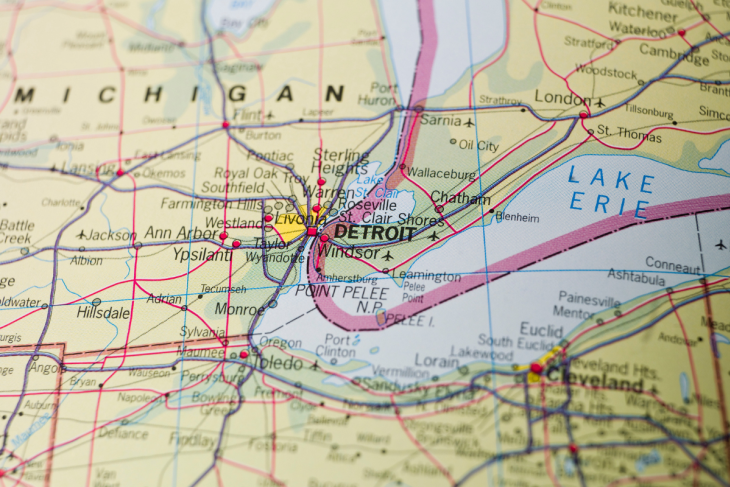After the Brown v. Board of Education decision, school desegregation efforts in Detroit followed a familiar pattern: Busing of students to achieve racial balance was proposed, resistance and White flight occurred, and somebody sued. Milliken v. Bradley was finally decided in the U.S. Supreme Court in 1974, rejecting the idea that outlying districts had to be part of Detroit City Schools’ desegregation solution. A city-suburb divide thus persists to this day, with school district lines approximating historically redlined housing boundaries.
Though the percentage of Black suburban residents has grown, the metro Detroit area remains one of the most segregated in the country. Over 80 percent of Detroit students today are Black, while over 60 percent of suburban students are White. The rise of school choice in the 1990s, meant mainly to provide better school options for underserved students, could also have chipped away at this geographic divide. A new report from Wayne State University researchers Jeremy Singer and Sarah Winchell Lenhoff looks at data on interdistrict open enrollment and suburban charter school attendance to see whether the divide has been meaningfully breached.
Michigan is ranked fairly highly by NAPCS in its most-recent report on model charter school laws across the country, and charters in the state are numerous, with few geographical constraints. Interdistrict open enrollment is more limited, as districts are allowed to remain closed entirely to transfer students or to limit the number of non-resident enrollees. The researchers suggest unrestricted “administrative burdens” also limit enrollment, even in districts that are ostensibly “open.” Furthermore, Michigan law does not require either sending or receiving districts to provide transportation, access to which is a huge problem in this sprawling metropolis, even for district residents staying put. The good news is that many students seem to have overcome these barriers. Previous research by Lenhoff shows that nearly one in four Detroit resident students attend school in the suburbs.
The new report uses statewide student attendance and census data from the 2015–16 school year to compare public school choices, resident addresses, and various school quality measures. Overall, 22,170 resident students left Detroit that school year to attend a public school option in the suburbs. The vast majority of exiters were Black, and much smaller percentages were Hispanic and White. It should be noted that, per state law, the category “White” includes Arab American students of Middle Eastern and North African heritage. Data indicate that members of these communities—large and concentrated in a specific part of the Detroit metro area—drive the exit patterns observed for White students. Sixty-three percent of exiters attended suburban charters, while the rest enrolled in suburban district schools. A whopping sixty-six different suburban districts received at least one exiter, but more than 50 percent of all exiters went to one of just four border districts: Southfield, Oak Park, Harper Woods, and Dearborn. The average exiter had to travel 4.5 miles to school each day, compared to 2.3 miles for Detroit resident students staying put and 2.0 miles for suburban resident students.
In “open” districts—that is, ones with little or no known restrictions in place to limit enrollment from outside their borders—slightly more exiters landed in a district school than in a charter. In “managed” districts where formal or informal limits exist, nearly 60 percent of exiters attended charters. And, somehow, 5 percent of exiters landing in a “closed” district still managed to get a seat in that district (think, for example, children of district employees), while the other 95 percent in those districts understandably went to charters.
Compared with their known set of school choices available within Detroit, the average exiter chose a school with slightly lower levels of racial isolation and about the same level of economic disadvantage. When it came to school quality, exiters, on average, enrolled in schools with a slightly lower discipline rate, a slightly higher stability rate, and somewhat better average math and English language arts state test scores. Singer and Lenhoff, however, express concern that Black exiters experience lower school quality than White, Hispanic, and Asian peers who likewise exit Detroit schools. Unfortunately, the nuances of quality ratings among schools are not included here, so it is difficult to ascertain the full measure of the gap; hopefully future research will illuminate these details. So the while primary goal of school choice programs—better schools for chronically-underserved students—seems generally to be reached, any deeper aims remain elusive.
The researchers specifically discuss the observation that exiters are “isolated” in their new schools—by which they mean Detroit resident students are not integrated with suburban resident students despite crossing borders. This is an important point. Exiters do attend suburban schools where an average of 51 percent of their classmates are also Detroit residents. A bit surprising, perhaps, but not outside the realm of possibility. One can surmise without too much concern that suburban families don’t choose charters (in 2015–16, that is; things may have already begun changing in that regard), but the possibility that school districts may be funneling their open enrollees to separate buildings does raise an eyebrow. While not proven by the data at hand, that possibility could be easily eliminated with common sense tweaks to open enrollment – including eliminating closed borders except in cases of buildings over capacity – which empower parents and limit longstanding “opportunity hoarding” often associated with high-cost housing zones and the districts that have historically arisen from them. Very likely, such changes would also allow exiters to land in even better new schools, accomplishing both the primary and secondary aims of public school choice.
SOURCE: Jeremy Singer and Sarah Winchell Lenhoff, “Race, Geography, and School Choice Policy: A Critical Analysis of Detroit Students’ Suburban School Choices,” AERA Open (January 2022).


